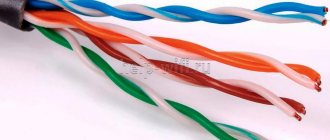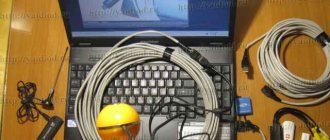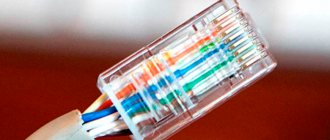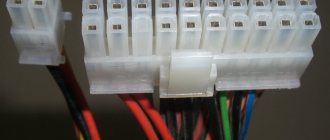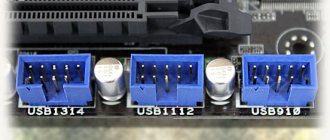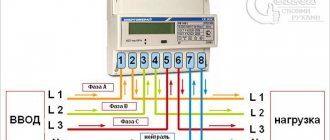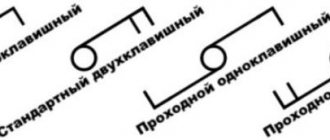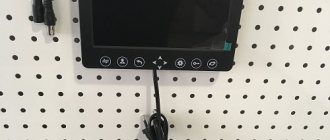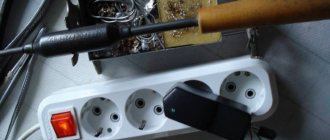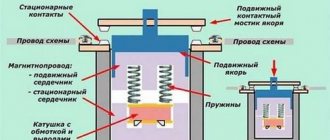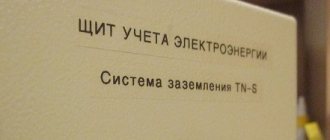In computer networks, various devices are connected to each other using a special connector known as the RJ 45 pinout - Registered Jack. In another way, it is called a network connector and is attached in a special way to the ends of the connecting cable - twisted pair. Next, we will consider and select a suitable color scheme according to which the conductors are distributed. With minimal knowledge and practical skills, twisted pair crimping is accessible even to novice users.
Features of twisted pair
A power cord consists of one or more pairs of thin conductors coated with insulation. They are all twisted in pairs, which is why they are called twisted pair. In practice, finished products are used in the form of a patch cord, where a piece of cable is crimped on both sides with plugs. They are inserted into special connectors available on the computer, router and other devices that need to be connected.
Sometimes when laying networks, a cable without crimping is used, passed through small holes in the walls that are impassable for the connector. In such cases, pinout and crimping are performed after laying the network.
The RJ45 Internet cable has the following characteristics:
- Conductor material and insulation. Copper or copper-coated aluminum is used for their manufacture. Each core is protected with colored insulation. The entire bundle of twisted pairs is additionally placed into a single, denser insulating sheath. A screen made of foil and other metallized materials is installed against interference.
- Color of the insulating layer. Classified according to the purpose of the cable. Twisted pair with black insulation is used outside, with gray insulation - indoors, with orange - in fire hazardous areas. The most modern cables are available in all sorts of colors, and their specific affiliation is indicated in the marking.
- Number of cores According to this indicator, cords are divided into single- and multi-core. Single-core ones contain monolithic veins with a diameter of 0.3-0.6 mm, characterized by low elasticity and fragility. Multistrand pairs use thin strands twisted into bundles. They bend and twist freely, without breaking at all. The twisted pair connector is also selected for them.
- Shielding. UTP cord is used indoors - without protective elements. External wiring is performed using foil materials (FTP) or metallized braiding (STP).
- Bandwidth. There are 10 categories for RJ45: 7 main and 3 additional. The 5th category is considered the most popular, since the first 4 are already outdated and do not support high transmission speeds.
All information about RJ45 is indicated in the markings printed on the outside of the insulation. It helps you select twisted pair cables for specific operating conditions.
What is twisted pair crimping and how to do it
Crimping a twisted pair is a mechanical installation on both ends of a multi-core cable. It is designed for differential signal of connectors with their subsequent crimping using special equipment in order to obtain the so-called patch cord. The general algorithm for these actions will be as follows:
- a piece of cable is prepared that has eight or four cores of the required length;
- the ends are stripped, and depending on the type of cable and connector there will be some nuances;
- the arrangement of the cores depends on the color scheme used;
- excess veins are cut off;
- the ends of the wires are inserted into the connector connector;
- the connector is inserted into a special lever device, where it is crimped.
Standard crimping patterns
The RJ 45 pinout and the subsequent twisted pair crimping procedure is done according to the international standard EIA/TIA-568. It is these requirements that are used when installing indoor networks. The twisted pair crimping scheme is selected according to the parameters of the network and the cable itself.
It is known that each connector is in a transparent plastic case, which clearly demonstrates the order of the laid out wires. If this sequence is not followed, the connection will not occur and the switching will be disrupted. Connecting a twisted pair, regardless of the number of conductors, can be done using different methods. Basic - direct or cross, schemes A or B.
Option – 1: Straight 8 conductor cable
This method is indispensable when directly connecting computers, laptops and other equipment to a router or switch. Here the crimp on each end will be the same, hence the name of this method.
The connection can be made using type A or B. In the Russian Federation, it is customary to use type B, where the pinout of the twisted pair starts with an orange-white wire and ends with a brown one.
In Europe and the USA, networks use type A, which also has 8 wires, only the orange-white and orange wires change places with the white-green and green wires.
These two methods are fully functional and the quality of the transmitted information does not depend on them. In each case, the most important thing is to observe the order of the colored wires.
Option – 2: 8-wire crossover
A crossover is a form of cross-compression of twisted pair RJ. The method is used when connecting two computers to each other. HUBs, which are ordinary concentrator devices that switch equipment, are connected in the same way.
Types of color schemes for crimping LAN cables
As already mentioned in the first section, when crimping, the cores must have the correct order of arrangement according to a certain color scheme. Despite the fact that today LANs most often use straight-through and crossover cables (they will be discussed below), there are other options. It should be noted that behind the scenes, for convenience, there is a rule that regulates how to read the color scheme. According to it, you need to take the connector and unfold it with the spring latch down, so that the back side is the bottom. Then the colors of the cores will be located from the left edge to the right, the pin numbers will be from 1 to 8. This is also convenient because it is in this position that the connector is inserted into the crimping device (you will not need to turn it). So, the layout of twisted pair wires for the Internet and LAN in general:
What are the differences between 3G and 4G networks: features, advantages and disadvantages
- Pinout of an 8-core network cable for the Internet. Option A (reminder: from left to right) - orange-white, orange, green-white, blue, blue-white, green, brown-white, brown. Option B – green-white, green, orange-white, blue, blue-white, orange, brown-white, brown.
- Two pairs from a four-pair Ethernet cable. When crimping two-pair cables, it is necessary to take into account the pin number: 1. Orange-white, 2. Orange, 3. Green-white, 6. Blue.
- Direct connection of two network cards.
 According to the EIA/TIA standard, you can connect two computers without using additional network equipment. To do this, the cord is laid out according to the following scheme: colors at one end (from 1 to - green-white, green, orange-white, blue, blue-white, orange, brown-white, brown. At the other end - orange-white, orange, green-white, brown-white, brown, green, blue, blue-white.
According to the EIA/TIA standard, you can connect two computers without using additional network equipment. To do this, the cord is laid out according to the following scheme: colors at one end (from 1 to - green-white, green, orange-white, blue, blue-white, orange, brown-white, brown. At the other end - orange-white, orange, green-white, brown-white, brown, green, blue, blue-white.
Note! Modern network cards support connection according to the option presented at the very beginning.
- IEEE 802.3af and IEEE 802.3at PoE standard for powering network devices over twisted pair cable. PoE technology (an abbreviation for Power on Ethernet) was created in order to provide power to network equipment without the use of additional cables, providing reference voltage transmission over twisted pair cables. In this case, the scheme will be as follows: orange-white, orange, green-white, blue, blue-white, green, brown-white, brown. In this case, a positive potential (+) is applied to the blue and blue-white pair, and a negative potential (-) is applied to the brown and brown-white pair.
- Two-pair patch cord for LAN. The color scheme for this case will be similar to the very first one in this list.
- Two-pair patch cord for connecting a network card and a switch. Due to the peculiarities of data transmission, this option uses only two pairs. Therefore, the color scheme is completely similar to the first option, but pins numbered 4, 5, 7, 8 are not crimped (wires are not inserted into them), and two types A and B are also available.
- Two-pair connection of two network cards. Similar to four pairs, wires are not inserted for pins 4, 5, 7, 8.
- Scheme for temporarily restoring the functionality of a patch cord during work on the line. Since the pairs are interchangeable, if a fault is detected, for example, on orange or green, they can be replaced with blue and brown, then for option A - 1. Blue-white, 2. Blue, 3. Brown-white, 6. Brown, for option B – 1. Brown-white, 2. Brown, 3. Blue-white, 6. Blue.
- One cable for connecting two computers to a switch or router. Due to the symmetry described above, it is possible to use one cord to connect computers to a switch or router using one cable. To do this, the first two pairs have a scheme - 1. Brown-white, 2. Brown, 3. Blue-white, 6. Blue, and the second two pairs are 1. Orange-white, 2. Orange, 3. Green-white, 6. Green.
- Using free lines for non-standard solutions. If you crimp the cable according to the first scheme, leaving the blue and brown pairs free, you can transmit, for example, a telephone signal through them.
Note! Under no circumstances should you use a differential pair to connect to a 220 volt power supply! This is dangerous not only for equipment, but also for life!
How to crimp an RJ 45 cable correctly
The further operability of the network depends not only on compliance with the pinout of the cores, but also on how well the RJ45 lan connector is crimped. To perform this task, you will need special tools that allow you to quickly connect the equipment. In addition, all actions must be performed precisely, in the prescribed sequence.
Selection and preparation of tools
Special tools greatly facilitate the work of crimping an Internet cable. With their help, it is possible to obtain a high quality connection, and such a network connector functions reliably for a long time.
The minimum set consists of the following equipment:
- Crimper or crimper. There are different types of these pliers, but professionals use universal ones that can crimp not only RJ45, but also any adapter with non-standard sizes. These pliers crimp network and telephone wires, which means their capabilities are much wider than those of a conventional tool.
- Stripper. Special cutters for careful removal of insulation without damaging the cores. Cannot cut cables with protective foil or shield, but they are not used indoors.
- Tester. Used to check the functionality of the network before connecting to ethernet rj. It consists of two modules with sockets for a connector of the rzh45 standard. The first module is master - the main one, the second - remote - remote. The ends of the wire are connected to both modules. There are indicators on the front panel. If the pinout of the conductors is correct, the green light will light up, if incorrect, the red light will come on.
- Crosser. An auxiliary tool equipped with hooks and other devices. Makes it easier to remove cores from under the insulation.
At home, you can get by with the first two tools. The correct RJ45 pinout can be checked without a tester. If you have the Internet, you just need to connect your computer to the network, and if everything works, then everything was done correctly.
Step-by-step instructions for crimping
To make a patch cord, you need to stock up on cables and connectors in advance, prepare tools and decide on the type of equipment connection. The color scheme should be printed in advance and used when distributing the conductors.
It is recommended to perform all actions in a certain sequence:
- Using wire cutters or a crimper, the RJ cable is cut to the required length.
- Using a stripper, the outer insulation is cut in a circle at a distance of 2-4 cm from the ends. After this, it must be carefully removed.
- Twisted pairs should be untwisted, the wires straightened and distributed according to the chosen color scheme. The nylon thread, hidden under the shell, is simply retracted so that it does not interfere.
- Alignment of the ends of the conductors. To do this, you need to step back from the edge of the outer insulating layer by about 10-13 mm and cut off the wires with wire cutters. The cutting line must be perpendicular to the axis of the twisted pair.
- Straight conductors are inserted into the connector and pushed in until it stops.
- In order to crimp an Internet cable, the connector with conductors is placed in the crimper connector, marked 8P. Next, the handles of the tool are compressed until they click.
- To make sure the fastening is secure, you need to lightly pull the cable out of the connector. If the wires are securely fastened, then the crimping is done correctly.
- Checking the functionality of the finished patch cord with a tester. The rzh connectors are inserted into the sockets, the device turns on and the indication lights up. When connected normally, the lights will be green. A red light or no indication at all indicates an error and the connection needs to be redone.
Practical skills are acquired very quickly; it is enough to do 3-4 wire crimps yourself. In a modern apartment, full of various equipment, these skills will come in handy many times in case of accidents, breakdowns or new connections. RJ45 is connected in the same way, the pinout of which is made according to a non-standard diagram.
Tool-free crimping
Not everyone in the household has a special tool, so in isolated cases you can do without it. The crimping procedure is performed with a flat screwdriver, blade width 3 mm. You will need a sharp knife and materials: the required number of connectors and a piece of twisted pair.
All actions are performed in strict sequence:
- The outer insulation is carefully removed with a knife.
- The wires are laid out sequentially, in accordance with the selected scheme.
- Excess ends are cut off with pliers and at the same time aligned in length.
- The connector unfolds with the hole facing you, with the latch facing down.
- The conductors, arranged by color, are carefully inserted into their channels until they stop.
- The screwdriver is installed on the contact plate, after which you need to hit its handle with something, not too hard. This must be done with each contact, after which they fall into the grooves and are 1 mm below the dividing jumper.
- After the contacts, you need to lightly hit the lock to firmly fix the cord itself.
- Upon completion, you need to test the functionality of the connection.
Examination
After installing the wired network and crimping the connectors, you need to check the functionality of the connection. For this purpose, there are special testers consisting of main and additional modules. The connectors are connected in pairs to each module and snap into their socket. There are indicators on the front side of the device.
Each core has its own light bulb. If all the indicators turn green, then the conductors are crimped correctly. If any light does not light up or blinks red, the crimping procedure will have to be repeated.
What is the difference between a patch cord and a twisted pair cable?
Twisted pair (Fig. 1) is a network cable consisting of one or more pairs of conductors twisted together. Used for laying communication lines. The ends remain free, which allows you to make segments of any length.
The patch cord (Fig. 2) is a connecting cord for connecting various devices to each other. Connectors corresponding to the connected equipment are installed at its ends. The length of patch cords can be different, and production can be factory or manual.
How to choose a network cable
We will tell you what you need to pay attention to when choosing a twisted pair cable.
- A very important point, you need to understand whether you will be laying the network cable indoors or outdoors. Because the simplest and cheapest twisted pair cable is suitable for internal installation. But for external use (outdoors), you need to take it with additional protection (double braiding that protects from natural phenomena, such as sun, rain, snow, frost).
- If the cable length is long, then take a twisted pair cable with additional wire. It will reliably keep the wire from breaking.
- Pay attention to the composition of the wire; it can be made of bimetal or copper. Of course, copper is better, but its price is several times higher. So, here you need to look at the budget allocated for the purchase and decide.
- The thickness of each core should be about 0.50 mm, ideally. But, alas, many manufacturers underestimate these figures to 0.40 mm.
- Look at the markings on the cable; a self-respecting manufacturer makes it clear and understandable. And an unscrupulous manufacturer applies such markings that when touched, they are erased, or they are not even on the cable at all.
- You can buy a network cable that has additional protection against various interference (thunderstorm, static). This cable has a foil-shaped shield.
- Availability of a quality certificate.
